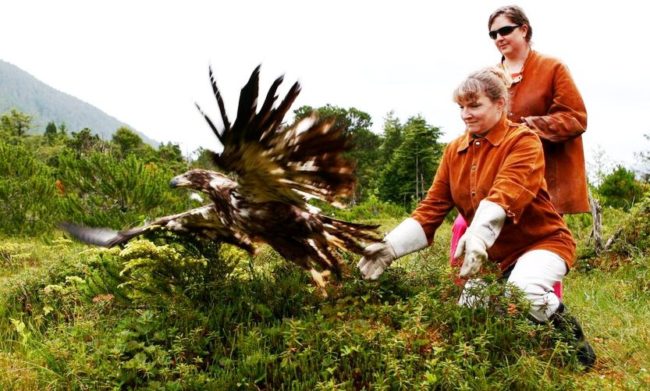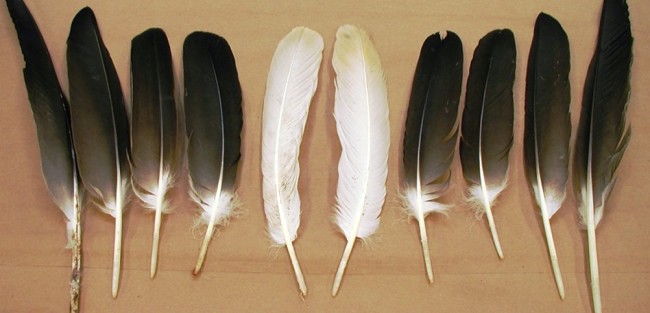
When an eagle dies in Alaska, its feathers may end up in a powwow — or on a graduation cap — somewhere in the Lower 48. That’s because of a federal program connecting tribes, raptor centers and wildlife officials.
A bald eagle is released back into the wild at the Alaska Raptor Center in Sitka. It’s one of hundreds treated for injuries, disease or malnourishment at centers around the state.
But the story doesn’t end with the flight.
That’s because the raptor center collects feathers rehabilitating birds lose while molting.
“Usually, that happens kind of towards the end of summer,” says Jennifer Cedarleaf, rehabilitation coordinator at the Sitka center. It collects eagle carcasses, as well as shed plumage from residents and those in rehabilitation.
“Our education birds that are here year-round, when they drop their feathers, we collect those. And they all just get saved up and I can send them down there,” she says.
“There” is the National Eagle Repository, run by the U.S. Fish and Wildlife Service near Denver, Colorado.
Only Alaskan Natives and American Indians are allowed to gather, store and use feathers or parts from eagles and some other protected birds — with a few exceptions.
If the plumage or parts aren’t available, the repository helps.
“It could be for folks who are in a powwow, dancing fans [or] bustles,” says Joseph Early, Native American liaison for the wildlife service’s Southwest region and a Laguna Pueblo tribal member.

“We have some of our tribes that use them for their very sacred ceremonies. Naming ceremonies, birth ceremonies, sometimes for funerals, graduations. It basically comes down to the individual member to be able to use that feature for however they want to,” he says.
Early discussed the program during the recent Native American Fish and Wildlife Society convention in Juneau.
He shared reports showing Alaska provided about 10 percent of the feathers, parts or whole eagle carcasses sent to the repository last year. But tribal members here only took half a percent of what was distributed.
“Eagles are fairly abundant up here, of course. But we may have some tribes up here that want golden eagles, which are a little more abundant in the Lower-48. We try to accommodate any tribes for what they want,” he says.
Tribes and members cannot give or sell eagle carcasses, feathers or parts to non-Native people.
Early says when that happens, the Fish and Wildlife Service gets involved.
“In that case … those feathers will be seized. But eventually, they could be returned back to the tribe. If not, they could end up at our … repository in Colorado,” he says.

While Alaska provides feathers from rehabilitation facilities, some Southwest tribal groups have built their own collection centers.
Early says a competitive grant program supports such construction.
“We’ve had a number of tribes establish tribal eagle aviaries where they’re allowed to retain birds that can no longer be released into the wild. They give them a good life and retain their molted features and redistribute them to their own tribal members.”
Those aviaries have first dibs when a rehabilitation center, such as Sitka’s, has an extra eagle that couldn’t survive on its own.
In addition to live birds, the Alaska Raptor Center collects carcasses for shipment to the federal repository.
Cedarleaf says one particularly bad year, more than 70 were tagged, frozen and mailed south.
“It is sad when you find a beautiful bird dead. And for us, it’s even more sad when we find one that’s banded that we knew. Like I had one that hit a powerline just a few weeks ago that we had when it was a baby. And that makes it more difficult,” Cedarleaf says.
She says knowing the carcasses will find a new use makes it a little easier.
